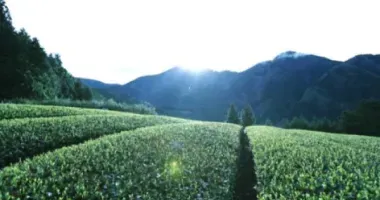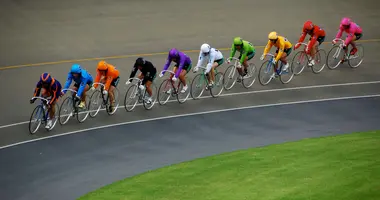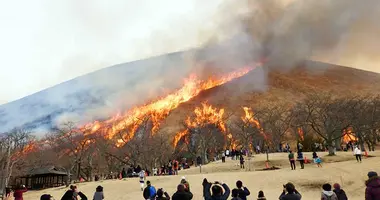Hamamatsu Kite Festival
Hamamatsu Festival: read an article on Hamamatsu Kite Festival in Hamamatsu, Shizuoka Prefecture including images, dates and access information.
Hamamatsu Festival: Alan Wiren sees the "The Children's Battle" 浜松祭

During the first week of May, the Great Sand Dune in Hamamatsu is transformed into an ancient battlefield.
Knots of excited men and women huddle around devices like engines of war. They are uniformed in happi coats, and fly their colors above. Each group has its own drum and bugle corps, and the air is thick with rumble and blast.
Not far away, in the cool shadows of the Hamamatsu Festival Museum, the fallen of years past -- charred ends of kite strings -- rest next to plaques that illustrate techniques for capturing your opponent's stirng and burning through it with the heat of friction.
Everything I have heard or read about this festival, before arriving in Hamamatsu, described it as a three-day-long, pitched battle among giant kites.
When the thud of the opening fireworks rolls like cannon fire over the flat grassy field at the foot of the dune, I am ready for the fight to begin. Huge spools begin to turn. Teams dash back and forth, pulling in, then releasing, the cords that trail after dozens of two meter square kites as they charge into the air. There, in the air, they remain. They float so serenely that, after a few minutes, it is hard to escape the feeling I am standing on some ocean floor, gazing up at gentle creatures browsing at the surface. Michiyo, a Japanese gentleman with a long white beard, squats beside the field with his friend, Kinta, who says things used to be different.
"They used to fight with the kites and people would" he shadowboxes for a moment, "People would fight and they would take off their clothes."
Michyo obligingly slips off his upper garments to display his tattoo covered torso. He holds up a hand to show the pinky is missing its first joint, the classic mark of the Yakuza.
"Traffic accident," he chuckles.
"Now," Kinta observes, "there a lot more rules, and the police are always watching."


History of Hamamatsu Festival
Hamamatsu festival has been through changes reaching back much further than Michiyo's or Kinta's memories, further even than Hamamatsu city herself.
Legend has it that in Japan's feudal era Hikuma castle stood in the place where Hamamatsu is today, and Iiwo Buzen-no-kami was its lord. When a first son was born to him, Iiwo raised a kite to celebrate. That remains the heart of the festival to this day: the raising of kites to celebrate the birth of a family's first child. Traditionally, it was the first son's birth that was honored, but nowadays the birth of a daughter is cause enough to celebrate.
A journey of celebration begins in the camp of rectangular, white tents pitched beside the field. Here, collections of two to three meter square kites, emblazoned with symbols identifying the neighborhood which it is from, are stacked against the side of every tent. Ichiro and his team have carefully laid one flat on the ground to adjust its bow and guide strings. They attach a symbolic braid of red and white cloth to the main string, then lift the kite onto their shoulders, holding it like a canopy while the family who sponsored its construction gather beneath.
Their first-born girl's name has been painted in the lower corner of this kite, and she is held in the position of honor. In this fashion, the kite, the team of flyers, and the family make a procession out to the field.
"Each neighborhood," Ichiro tells me, while the kite begins to climb, "is allowed to have only one kite in the air at any time." Even so, the air is full of cords arcing downward.
"It is difficult," he says, "to get the kite up to a good height and avoid getting caught in the other strings." When the kite is flying well, the daughter is perched onto her father's shoulders. Her mother is lifted onto the shoulders of a team member, and handed the kite's cord. The rest of the team gather around, the drum and bugle corps strikes up, and everyone chants "Oisho!, Oisho!" while mother pulls the kite string back and forth. The raising of a kite is symbolic of a child growing up tall and strong. No one would think of attacking this kite on its maiden flight. It would be an ill omen.


When it is over, and pictures taken, the procession returns to the tent. Inside food is heaped on tatami covered benches, and canned drinks stand in barrels of ice. Over a beer Ichiro tells me:
"The purpose of this festival is to improve the relationships between the people of each neighborhood." This is the other theme that has grown up along with the festival. "I want to expand on that idea," Ichiro says, "I think the festival is a good place for making international friendships, too." He is probably right.
The field is constantly full of kite flying teams, and hundreds of people stroll around the edges, sample the snacks sold from the circling stalls, or sit in the shade of the bordering pine grove. The mood throughout the Hamamatsu festival is one of such warmth and welcome that only the crustiest curmudgeon could fail to get involved. You need only show the slightest interest and someone will be handing you a happi coast and asking you to put your back into the raising of a kite.
Nowadays, it is only on the morning of the third day that any battle takes place. It is when the children fly the kites. The lines are deliberately crossed, and the purpose of chanting and back and forth movement of the kite string become clear.
Typically, four or five lines are tangled together and long rows of children rock the cords back and forth while everyone chants "Oisho!" and the drums and bugles go full blast. Kites do fall out of the sky at this time, but the murmurs from all around seem to be true.
The real techniques of fighting with kites have been all but lost in Hamamatsu. The great battle has become a children's game that lasts half an hour. After that, the regular teams return to the field and the kites rise up again in peace.


Access - Getting to Hamamatsu Festival in Hamamatsu, Shizuoka Prefecture
Hamamatsu Festival is held on the 3rd, 4th, and 5th of May.
Public transportation runs from Japan Railway's Hamamatsu Station to the Hamamatsu Festival Museum every day during the festival. The Great Sand Dune is about a ten minute walk from the museum.
Text and Photos by Alan Wiren




















